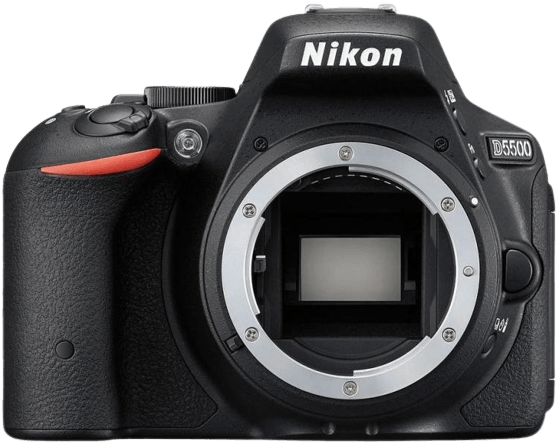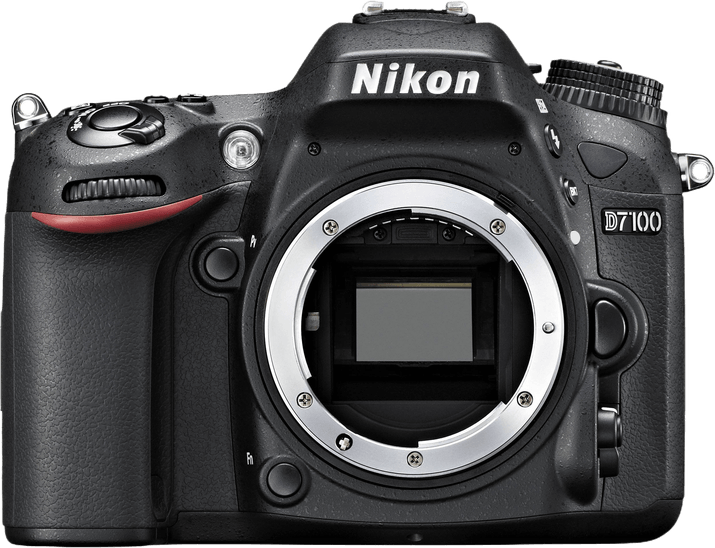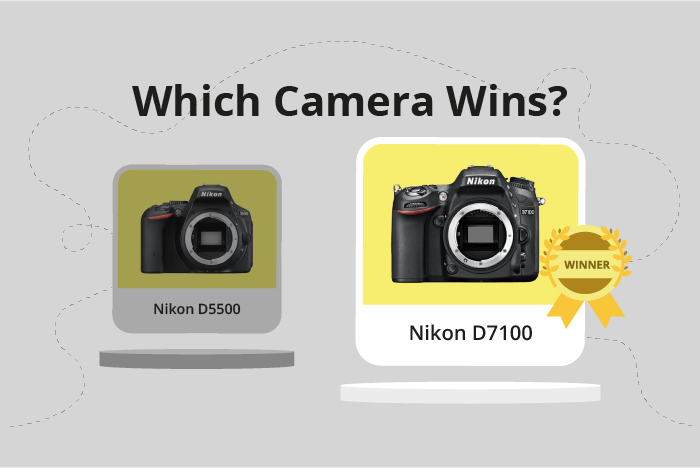Nikon D5500 vs D7100 Comparison
Nikon D5500

Nikon D7100

The Nikon D7100 comes out on top with a score of 65/100, while the Nikon D5500 follows closely with a score of 61/100. Both cameras are DSLR models, introduced in 2013 and 2015, respectively. The D7100 has a higher launch price of $1200, compared to the D5500’s $900.
Common specifications between the two cameras include their camera type (DSLR) and announcement dates. The D7100 stands out with its larger size (136 x 107 x 76mm) and heavier weight (765g or 1.69lbs), making it a more robust option.
On the other hand, the D5500 is more compact (124 x 97 x 70mm) and lighter (420g or 0.93lbs), which may be preferred by those seeking a more portable camera. Ultimately, the choice between these two cameras will depend on individual preferences for size, weight, and budget.
Nikon D5500 vs D7100 Overview and Optics
The Nikon D7100 emerges as the winner in optics, scoring 67/100, while the Nikon D5500 scores 65/100. Both cameras share several specifications, such as having a CMOS sensor, an APS-C sensor size, a Nikon F DX lens mount, and no image stabilization. Additionally, the D5500 has 24.2 megapixels and an Expeed 4 processor, whereas the D7100 has 24.1 megapixels and an Expeed 3 processor.
The D7100’s higher score is due to its faster shooting speed of 6 frames per second, compared to the D5500’s 5 frames per second. This difference allows the D7100 to capture fast-moving subjects more effectively, making it a better choice for action photography. Additionally, the D7100 has a slightly lower DXOMARK sensor score of 83 compared to the D5500’s 84, but the difference is negligible and does not significantly impact image quality.
The D5500, despite its lower score, has some advantages too. It features a higher megapixel count of 24.2, which results in slightly more detailed images than the D7100’s 24.1. Furthermore, the D5500 has a more advanced Expeed 4 processor, which allows for faster image processing and better performance in low light conditions.
In the optics comparison, the Nikon D7100 proves to be the better choice due to its faster shooting speed, making it more suitable for action photography. However, the Nikon D5500 should not be disregarded, as its higher megapixel count and more advanced processor also contribute to its image quality. Both cameras are capable options, but the D7100 takes the lead in this specific aspect.
Nikon D5500 vs D7100 Video Performance
When comparing the video capabilities of the Nikon D5500 and the Nikon D7100, the D5500 emerges as the winner with a video score of 70/100, a difference of 13 points from the D7100’s score of 57/100. Both cameras share common specifications in terms of maximum video resolution and dimensions, offering Full HD resolution at 1920 x 1080 pixels. Additionally, both models have built-in time-lapse functionality.
The Nikon D5500 outshines the D7100 in video frame rate, as it can capture videos at a maximum of 60 frames per second (fps), while the D7100 is limited to 30fps. This higher frame rate allows the D5500 to provide smoother and more detailed footage, particularly in fast-paced scenes or when capturing slow-motion videos.
On the other hand, the Nikon D7100 does not offer any significant advantages over the D5500 in terms of video capabilities. Both cameras share the same maximum video resolution, dimensions, and time-lapse functionality, but the D7100 falls short in frame rate.
Taking all factors into consideration, the Nikon D5500 is the superior choice for videography due to its higher video score and better frame rate performance. The D7100, while still offering decent video quality and features, does not provide any additional benefits to justify its lower score. Therefore, for users prioritizing video capabilities, the Nikon D5500 is the recommended option.
Nikon D5500 vs D7100 Features and Benefits
The Nikon D5500 and Nikon D7100 both have a feature score of 59/100. They share several specifications, including a 3.2-inch screen, no GPS, WIFI connectivity, and no Bluetooth capabilities. However, there are differences that make one camera more appealing than the other, depending on individual preferences and needs.
The Nikon D5500 is superior in terms of its touchscreen capabilities and flip screen. The touchscreen allows users to navigate menus and adjust settings more easily, while the flip screen provides flexibility for shooting at various angles. These features make the D5500 more user-friendly, especially for those who value convenience and ease of use.
On the other hand, the Nikon D7100 boasts a higher screen resolution of 1,228,800 dots compared to the D5500’s 1,037,000 dots. This means that the D7100’s screen provides a clearer and more detailed display, allowing users to better review their images and videos. The absence of a touchscreen and flip screen might not be a significant drawback for those who prioritize image quality and detail.
Both cameras have their strengths and weaknesses, and the choice between them depends on individual preferences. The Nikon D5500 is ideal for users who value convenience and user-friendly features, while the Nikon D7100 is better suited for those who prioritize image quality and detail. Ultimately, the decision comes down to what features are most important to the user, as both cameras offer a solid performance with a feature score of 59/100.
Nikon D5500 vs D7100 Storage and Battery
The Nikon D7100 outperforms the Nikon D5500 in storage and battery, scoring 76/100 compared to the D5500’s 35/100. Both cameras accept SD, SDHC, and SDXC memory cards. However, the D7100 has two memory card slots, while the D5500 only has one. This feature allows the D7100 to store more images and videos, providing greater flexibility for photographers.
In terms of battery life, the D7100 can capture 950 shots per charge, which is superior to the D5500’s 820 shots. The D7100 uses the EN-EL15 battery type, which is more efficient compared to the D5500’s EN-EL14 battery. Neither camera supports USB charging.
Although the D7100 has a better storage and battery performance, the D5500 still offers decent battery life and storage capacity for its price range. However, for those who prioritize longer shooting sessions and more storage options, the D7100 is the clear winner.
Alternatives to the Nikon D5500 and D7100
Are you still undecided about which camera is right for you? Have a look at these popular comparisons that feature the Nikon D5500 or the Nikon D7100:

